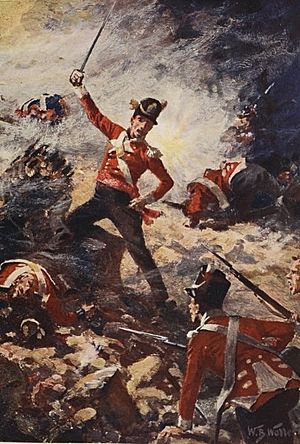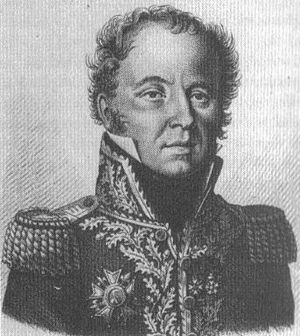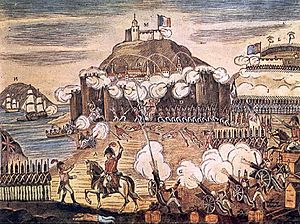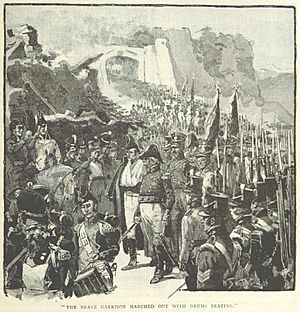Siege of San Sebastián facts for kids
Quick facts for kids Siege of San Sebastián |
|||||||
|---|---|---|---|---|---|---|---|
| Part of Peninsular War | |||||||
 The Storming of San Sebastian by Denis Dighton |
|||||||
|
|||||||
| Belligerents | |||||||
| Commanders and leaders | |||||||
| Strength | |||||||
| 9,750 | 3,380 | ||||||
| Casualties and losses | |||||||
| 1,200 killed 3,800 wounded 300 missing |
1,900 killed or wounded 1,200 captured |
||||||
| Hundreds to thousands of civilians massacred by the British and Portuguese forces | |||||||
The Siege of San Sebastián was an important event during the Peninsular War. This war was fought between France and a group of countries including Britain, Portugal, and Spain. The siege happened from July 7 to September 8, 1813.
At first, the Allied forces, led by Arthur Wellesley, tried to capture the city of San Sebastián but failed. Later, a second attack led by Thomas Graham succeeded. They captured the city from the French army. However, after the city was taken, the British and Portuguese soldiers caused a lot of damage. They burned much of the city to the ground.
Contents
Why San Sebastián Was Important
After a big win at the Battle of Vitoria in June 1813, Wellington's army moved into the Pyrenees mountains. Their goal was to control the mountain passes. They also wanted to push the French army, led by Marshal Soult, back into France.
To make sure their path was clear, Wellington needed to capture two cities: Pamplona and San Sebastián. He didn't have enough soldiers or supplies to attack both at once. So, Pamplona was surrounded to cut off its supplies (a blockade). San Sebastián was put under a siege, meaning it was surrounded and attacked directly.
The blockade of Pamplona worked. The French soldiers there eventually surrendered in October 1813 because they ran out of food.
Who Fought in the Siege
The French army defending San Sebastián had about 3,170 soldiers. They were led by General of Brigade Louis Emmanuel Rey. They had 76 cannons to protect the city.
The Allied forces were led by Sir Thomas Graham. He commanded about 9,000 British and Portuguese soldiers. They also had 40 heavy cannons to attack the city walls.
Historians say that some of the Allied soldiers were mercenaries. These were soldiers who fought mainly for money and treasure.
The City of San Sebastián
San Sebastián (also called Donostia in Basque) was a city with about 9,104 people. It was located on a piece of land that stuck out into the Bay of Biscay.
The city's defenses were very strong, especially on the south side. There was a large hornwork (a type of fort) that blocked attackers. The city walls also had cannons that could fire over this fort.
The eastern side of the city was protected by the Urumea River. British engineers found a weak spot near the river on the southeast side. They realized that at low tide, soldiers could cross the riverbed and attack the city from the south and east. This meant they could place their cannons on the east side of the river.
The British navy couldn't help much because their ships were not strong enough to block the French ships. French ships often brought supplies and more soldiers to San Sebastián. This meant Wellington couldn't just wait for the city to run out of supplies. He had to break through the walls and attack.
First Attack on San Sebastián
The first goal was to capture a convent (a religious building) on a hill south of the main fort. On July 11, the British started building cannon positions. By July 17, they had fired so much that the convent was destroyed. They then captured it easily.
On July 13, more cannon positions were built east of the river. These cannons fired at the city walls. By July 23, they had made three large holes, called breaches, in the walls.
On July 25, the Allied soldiers launched their first big attack. Before the attack, a mine was set off under the ground. However, it exploded too early, while it was still dark. The soldiers attacked the fort and the holes in the walls. But without light, the cannons couldn't help them. The soldiers faced heavy fire and were forced back. Many lives were lost.
The British lost 693 soldiers killed or wounded, and 316 were captured. The French lost 58 killed and 258 wounded.
Because the attack failed and they were running low on ammunition, the siege was paused. Wellington also learned that the French army was attacking elsewhere. So, the British cannons were moved to ships for safety. During this break, the French soldiers in San Sebastián made several small attacks, capturing some Portuguese soldiers.
Second Attack on San Sebastián
After pushing the French army back, Wellington focused on San Sebastián again. He waited for more supplies and cannons to arrive from England. By August 15, the French commander, Rey, had only about 2,700 healthy soldiers left.
On August 19, British supplies began to arrive. By August 23, their cannons were ready to fire again. On August 26, the British had 63 cannons firing at the city. They destroyed towers and made more holes in the walls.
On August 27, British sailors captured a small island called Santa Clara in the bay. They moved six cannons onto the island. These cannons could fire along the city's defenses, making it harder for the French. The French were surprised because they thought the island was too steep to attack.
The main hole in the east wall was now very long, about 500 feet.

The next attack was planned for August 31 at 11:00 am, when the tide was low. Another mine exploded, which helped break a wall but also created large holes in the ground. Soldiers rushed across the ground to the main hole in the wall. The French fired heavily, and many British soldiers were killed trying to climb the wall.
The French had built a hidden inner wall that stopped the British soldiers. Hundreds of British soldiers died. Even when more soldiers joined the attack, they couldn't break through. A Portuguese group tried to cross the river and attack another hole, but they also got stuck. After two hours, the attack was failing.
Then, Graham decided to fire his heavy cannons at the inner wall, even though it was risky for his own soldiers. When the cannons fired over their heads, the soldiers on the ground were scared. But when the smoke cleared, they saw that the inner wall was mostly destroyed. With a cheer, they charged forward, climbed the wall, and entered the city. The French soldiers retreated to the castle on Urgull hill. By midday, the Allied forces had taken over the town.
It was amazing that none of the cannon shots hit the Allied soldiers, even though they were firing from far away. About 700 French soldiers were captured in the town, which was now on fire.
Rey and the remaining French soldiers held out in the Castle until September 5. They formally surrendered on September 8. As a sign of respect for their brave defense, the French soldiers were allowed to march out with their flags flying and drums playing. Their officers could keep their swords.
The City Burns
After entering the town, the British and Portuguese soldiers became very angry because of the many losses they had suffered. They began to destroy and burn the city. Many people living in the city were hurt or killed. The burning started on August 31 and continued for seven days. Most of the city's 600 houses were burned to the ground. Only about 30 houses on Trinity Street were saved. These houses were chosen to host the British and Portuguese commanders.
After the fire, the town council and the people who survived met to decide how to rebuild the town. They decided to rebuild it almost completely. A new council was chosen, and they asked Wellington for money to help the people. Wellington refused and said he was not responsible for the burning. He blamed the French for the destruction.
The burning of San Sebastián is remembered every year on August 31 with a special ceremony.
What Happened Next
Of the French soldiers, 850 were killed, 670 were captured, and 1,860 surrendered. Many of those who surrendered were sick or wounded. The Allied forces lost 3,770 soldiers killed, wounded, or missing. In the final attack alone, 867 men died.
On the same day as the final attack, August 31, Marshal Soult launched another attack. But Spanish forces stopped him at the Battle of San Marcial. With San Sebastián captured, Wellington could now plan to push Soult's army back into France. The next battles were the Battle of the Bidassoa in October and the Battle of Nivelle in November. The French soldiers in Pamplona surrendered to the Spanish on October 31.
See also
 In Spanish: Asedio de San Sebastián para niños
In Spanish: Asedio de San Sebastián para niños





